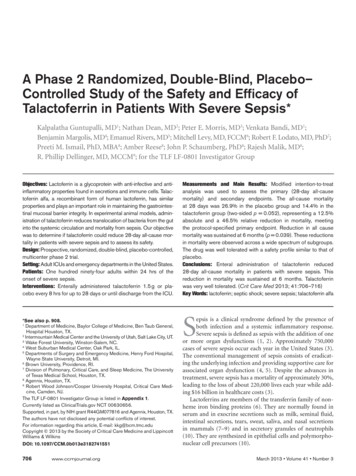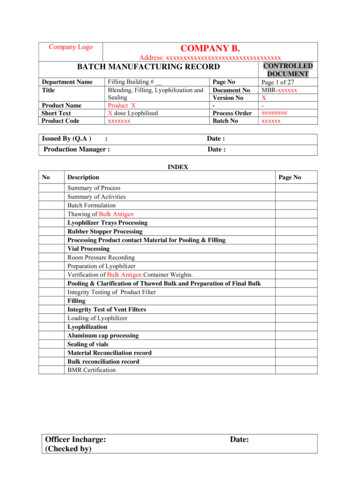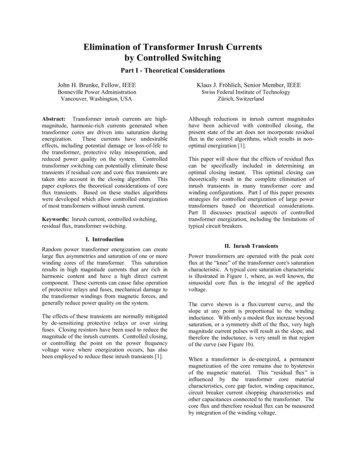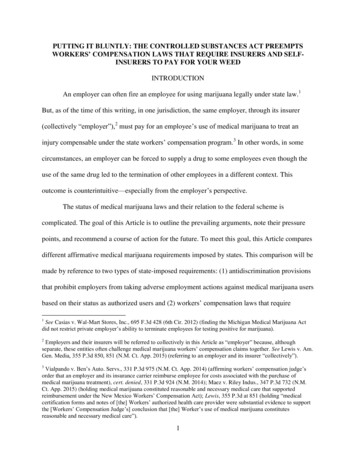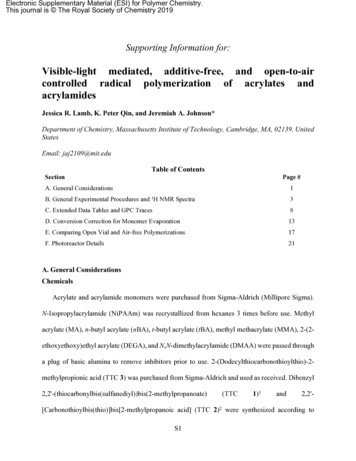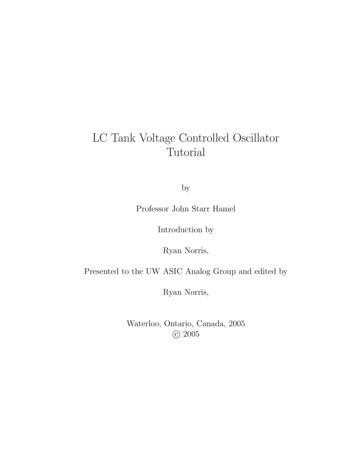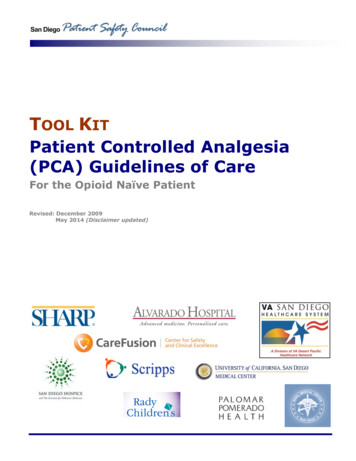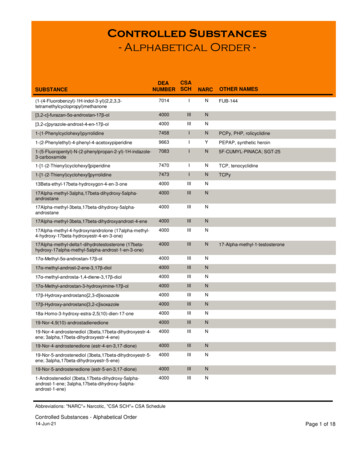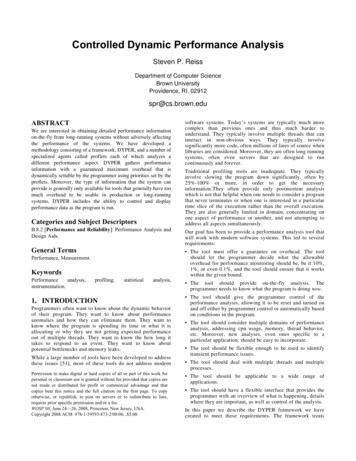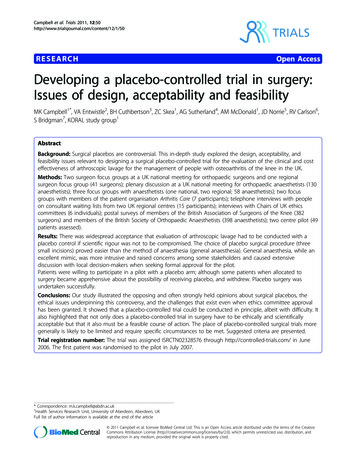
Transcription
Campbell et al. Trials 2011, ESEARCHTRIALSOpen AccessDeveloping a placebo-controlled trial in surgery:Issues of design, acceptability and feasibilityMK Campbell1*, VA Entwistle2, BH Cuthbertson3, ZC Skea1, AG Sutherland4, AM McDonald1, JD Norrie5, RV Carlson6,S Bridgman7, KORAL study group1AbstractBackground: Surgical placebos are controversial. This in-depth study explored the design, acceptability, andfeasibility issues relevant to designing a surgical placebo-controlled trial for the evaluation of the clinical and costeffectiveness of arthroscopic lavage for the management of people with osteoarthritis of the knee in the UK.Methods: Two surgeon focus groups at a UK national meeting for orthopaedic surgeons and one regionalsurgeon focus group (41 surgeons); plenary discussion at a UK national meeting for orthopaedic anaesthetists (130anaesthetists); three focus groups with anaesthetists (one national, two regional; 58 anaesthetists); two focusgroups with members of the patient organisation Arthritis Care (7 participants); telephone interviews with peopleon consultant waiting lists from two UK regional centres (15 participants); interviews with Chairs of UK ethicscommittees (6 individuals); postal surveys of members of the British Association of Surgeons of the Knee (382surgeons) and members of the British Society of Orthopaedic Anaesthetists (398 anaesthetists); two centre pilot (49patients assessed).Results: There was widespread acceptance that evaluation of arthroscopic lavage had to be conducted with aplacebo control if scientific rigour was not to be compromised. The choice of placebo surgical procedure (threesmall incisions) proved easier than the method of anaesthesia (general anaesthesia). General anaesthesia, while anexcellent mimic, was more intrusive and raised concerns among some stakeholders and caused extensivediscussion with local decision-makers when seeking formal approval for the pilot.Patients were willing to participate in a pilot with a placebo arm; although some patients when allocated tosurgery became apprehensive about the possibility of receiving placebo, and withdrew. Placebo surgery wasundertaken successfully.Conclusions: Our study illustrated the opposing and often strongly held opinions about surgical placebos, theethical issues underpinning this controversy, and the challenges that exist even when ethics committee approvalhas been granted. It showed that a placebo-controlled trial could be conducted in principle, albeit with difficulty. Italso highlighted that not only does a placebo-controlled trial in surgery have to be ethically and scientificallyacceptable but that it also must be a feasible course of action. The place of placebo-controlled surgical trials moregenerally is likely to be limited and require specific circumstances to be met. Suggested criteria are presented.Trial registration number: The trial was assigned ISRCTN02328576 through http://controlled-trials.com/ in June2006. The first patient was randomised to the pilot in July 2007.* Correspondence: m.k.campbell@abdn.ac.uk1Health Services Research Unit, University of Aberdeen, Aberdeen, UKFull list of author information is available at the end of the article 2011 Campbell et al; licensee BioMed Central Ltd. This is an Open Access article distributed under the terms of the CreativeCommons Attribution License (http://creativecommons.org/licenses/by/2.0), which permits unrestricted use, distribution, andreproduction in any medium, provided the original work is properly cited.
Campbell et al. Trials 2011, ackgroundThe placebo-controlled trial is a widely accepted designfor evaluating pharmacological and device interventions.There has, however, been considerable debate in the literature about the ethical acceptability of including a placebo in procedures such as surgery. Whilst the use of aplacebo in surgical trials is not new [1-8] the conceptremains highly controversial. Several commentators haveargued that placebo procedures are ethical for certaintrials of surgery [9], but others have argued stronglythat the use of surgical placebos cannot be justified asany surgical procedure carries risks of harm that aregreater than those associated with no surgery [10,11].The term “placebo” is commonly used to describe anysubstance or procedure a patient accepts as medicine ortherapy, but which has no known mechanism otherthan a patient’s belief in its value [12]. The aim of anyplacebo is to maximise the mimic of the active intervention (and its benefits) whilst minimising the risks associated with it [13,14]. A range of interventions, fromdummy pills to surgical techniques, have been used asplacebos [14]. Within a surgical context, however, nosurgical placebo can be completely without the possibility of harm. This leads to particularly complex issueswhen trying to design a surgical placebo-controlled trial.In this paper we report on a study (the KORAL study)conducted to assess the design, acceptability, and feasibility issues relevant to designing a surgical placebocontrolled trial for the evaluation of the clinical and costeffectiveness of arthroscopic lavage (washing out of theknee space under general anaesthetic) for the management of people with osteoarthritis of the knee in theUK. Whilst the primary focus was on arthroscopiclavage (and was written up in a separate monograph[15]), the study highlighted a range of wider issues relevant to the design and conduct of surgical placebocontrolled trials in general, and it is those that we focuson in this paper.The KORAL studyOur group was commissioned by the UK National Institute for Health Research Health Technology Assessment(NIHR HTA) Programme to design and conduct aplacebo-controlled trial to assess the clinical and costeffectiveness of arthroscopic lavage for the managementof people with osteoarthritis of the knee in the UK. Thepurpose of the trial was to confirm or refute the findings of an earlier study conducted in the US by Moseleyand colleagues [16]. In the Moseley trial, patients hadbeen randomised to arthroscopic lavage, arthroscopicdebridement or placebo procedure and had found thatwhilst all groups improved, no significant difference wasobserved at follow-up between the placebo group andeither ‘active’ surgery group; the conclusion being thatPage 2 of 12observed benefit was due to the placebo effect. Whilstthe Moseley trial had been conducted with methodological rigour, it had been conducted in a single US centreby a single surgeon and the generalisability of the resultshad been questioned by a number of authors [17-19].Given that it was unclear whether an acceptable placebocould be designed and delivered in a feasible manner,the project first explored in an in-depth manner issuesaround the design, acceptability and feasibility of a surgical placebo for this trial (it is this in-depth study thatis presented in this paper).This study, which was known as KORAL (KneeOsteoarthritis: Role of Arthroscopic Lavage) had the following research questions (RQs) that were addressed ina staged way in a series of sub-studies:RQ1. Is there a need for a further placebo-controlledtrial of arthroscopic lavage for osteoarthritis of theknee? If yes,RQ2. Can an appropriate surgical and anaestheticplacebo be designed for such a trial? If yes,RQ3. Would key stakeholders find the proposedplacebo-controlled trial design acceptable? If yes,RQ4. Would conducting such a multi-centre surgicalplacebo-controlled trial be feasible in the UK?MethodsThe research was conducted in two main phases. Firstly,an in-depth qualitative and quantitative exploration ofpossible placebo designs and their acceptability to keystakeholder groups (addressing RQs1-3) was conducted.Secondly a formal pilot of the proposed trial design totest feasibility (RQ4) was undertaken. Multi-centreResearch Ethics Committee (MREC) approval wasreceived separately for the two phases. Full details of themethods used in this study were given in the clinicalmonograph [15], however, brief details are providedbelow.Exploration of possible placebo designs and theacceptability of a placebo-controlled trial to keystakeholder groupsIn the first phase, we particularly addressed: a) the perceived scientific merit of further evaluation of arthroscopic lavage (including by placebo-controlled trial);b) the choice of the placebo procedure, both surgicaland anaesthetic; and c) the likely acceptability of different placebo-controlled trial designs to key stakeholdergroups including surgeons, anaesthetists, potential participants and chairs of ethics committees.We conducted focus groups with, and postal surveysof, surgeons and anaesthetists; focus groups and interviews with people with osteoarthritis (potential trialparticipants); and interviews with Chairs of MRECs(Table 1). Focus group discussions were informed by a
Campbell et al. Trials 2011, age 3 of 12Table 1 Details of those who contributed to the focus groups, interviews and surveysStudy componentNumber who participatedFocus groups with health professionals: two surgeon focus groups at the 2005 British Orthopaedic Association meeting16 surgeons one regional surgeon focus group25 surgeons plenary discussion at the 2005 British Society of Orthopaedic Anaesthetists meeting detailed focus group at the 2005 British Society of Orthopaedic Anaesthetists meeting two regional focus groups with anaesthetists130 anaesthetists8 anaesthetists50 anaesthetistsFocus group and interviews with people with osteoarthritis: two focus groups with members of the patient organisation Arthritis Care telephone interviews with patients on consultant waiting lists from two UK regional centres7 people15 peopleInterviews with Chairs of UK MRECs: telephone interviews with MREC Chairs6 MREC ChairsSurveys of health professionals: postal survey of all members of the British Association of Surgeons of the Knee382 surgeons postal survey of all members of the British Society of Orthopaedic Anaesthetists398 anaesthetistsNote: 12 of the 13 UK MRECs which were in existence at the time of the research were invited to take part in the research. (To preserve their independence withregard to any future ethics decisions about KORAL, the MREC that approved this part of the study was excluded from this component).presentation from the project team on backgroundrates of arthroscopic lavage, details of the Moseley trial(including the design, results and perceived criticisms)and the project brief. Focus group discussions andinterviews were audio-tape recorded and transcribed.Transcripts were analysed thematically using a modified Framework approach [20]. Within the focusgroups and interviews we used the term “placebo surgery” (rather than possible alternatives such as “sham”or “dummy” surgery) as early on in the research wefound that the choice of word could lead to differentperceptions, despite the rationale behind their usebeing the same [15]. The term “placebo surgery” wasadopted in an attempt to describe as accurately as possible the intention behind the procedure ie, to maximise the mimic, whilst minimising the risk.All members of the British Association of Surgeons ofthe Knee and members of the British Association ofOrthopaedic Anaesthetists were surveyed for their opinion. Permission was received from both Societies foronly a single mailing to members. Responses to the surveys were summarised using simple descriptive statistics.The final output of this first phase was the templatefor a preferred trial design.Formal pilot of the proposed trial design to testfeasibilityThe second phase was a formal pilot of the preferredtrial design that had been developed in Phase One. Theformal pilot was conducted in two centres. Analysis ofthe pilot data consisted primarily of descriptive statisticsincluding proportion of eligible patients randomised,and reasons for refusing to take part in the trial.ResultsNeed for proposed further evaluation of arthroscopiclavageFrom the focus groups and interviews, there was broadacceptance across all stakeholder groups of the need tofind out more about the effects of arthroscopic lavage.Surgeons expressed uncertainty about the overall effectiveness of lavage. On the one hand some indicated thatthere was some evidence to suggest that lavage mightoffer at least short-term pain relief:“if . you end up washing the knee out, sometimes thesymptoms do improve and make it pseudo-working.We had a lady recently, and she had a defect, andshe’s a lot better since we washed the knee out, that’sthree weeks ago now.” (Surgeon 1, Group C)However, others commented that they often observedtheir patients “all coming back” with continuing problems after the procedure, thus raising concerns aboutthe longer term and overall effectiveness of thetechnique.People with osteoarthritis of the knee also expressedthe need to find out definitively whether arthroscopiclavage was effective. For example, one mentioned thescientific uncertainty surrounding the effectiveness ofarthroscopic lavage, and another highlighted the needfor research into the long-term effectiveness of such surgical procedures:“Well, we have got to find out, you know, it has beengoing on for years and years and no one has everfound a complete answer so things have got to be
Campbell et al. Trials 2011, age 4 of 12tried, you know. If you want to advance that is whatyou have to do."(Participant 1)“I certainly think it [a trial of arthroscopic lavage] isworthwhile because at the end of the day .I don’tthink that people should undergo surgery unless itwas having some long term benefit to them . itshould only be done when it is going to have a positive effect and a long lasting effect.” (Participant 2)would not only maximise the mimic of the active surgery but would also minimise the risks to participants.As they had more experience with general anaesthesiain these cases, they believed it would be safer than atechnique using a combination of sedatives and analgesics as used in the Moseley trial (on the premise that itwas less risky for their patients), but was felt to be lessfamiliar and therefore less safe by our respondents:Although all the groups accepted there was a need tofind out more about the effects of arthroscopic lavage,there was variation in opinion about how researchersshould investigate this and about whether it would beacceptable to investigate the effectiveness of arthroscopic lavage using placebo surgery. This is discussedbelow.“Hasn’t the starting point got to be, you should dothe same [as for the active surgery group] unlessthere is a really good reason not to? And if the reallygood reason is all about risk then you have to showthat their [the sedation procedure used by the Moseley trial, on the grounds that it was of lower risk topatients] intervention has less risk than the standardfull anaesthetic. I am convinced that that is not thecase. So therefore you should do the standardstraightforward general anaesthetic” (Anaesthetist 5,Group B)“Statistically, [the sedation procedure used by theMoseley trial], is more dangerous than a generalanaesthetic [on the grounds that it was of lower riskto patients]” (Anaesthetist 6, Group A)Design of a surgical placeboDiscussion within the surgeons’ focus groups concentrated mainly on the ways in which a placebo couldmimic arthroscopic lavage (the active surgery), whilstensuring that any risks of harm were minimised. Theconsensus emerged fairly readily that three superficialskin incisions were needed, that these should only piercethe epidermis, and that any penetration of the knee capsule should be avoided.“No, you don’t have to do the dermis . just enoughto make it bleed” (Surgeon 8, Group B)Ensuring that penetration of the knee capsule did notoccur was promoted for two primary reasons: a) that itwould reduce the risk of any infection and b) it wouldensure that no form of lavage was inadvertently performed:“If you put the scope in you introduce fluid thereforetechnically it becomes a lavage even if it’s a tinyamount, doesn’t it?” [several yes’s round the table](Surgeon 7, Group C)Within the anaesthetists’ focus groups, the questionabout the most appropriate form of anaesthesia toincorporate within a placebo procedure was more contentious. Some anaesthetists objected to the ethics ofconducting any research that involved a placebo (seeacceptability section below), and did not feel comfortable discussing the design of an anaesthetic for such aprocedure. However, a consensus eventually emergedthat the patients in both trial groups should receive thesame anaesthetic, and that this should be the regimenthe individual anaesthetists who participated in the trialwould customarily use for a simple arthroscopic procedure (i.e. a general anaesthetic). They believed that thisAssuming that general anaesthesia was to be adopted,the anaesthetists within the focus groups agreed thatinclusion should be restricted to low risk patients, asdefined by those who were American Society ofAnesthesiologists (ASA) grades 1 or 2 [21,22] - that is“normal healthy patients” or “patients with mild systemic disease” who had no other contraindication toanaesthesia.Acceptability of a surgical placebo-controlled trialViews expressed by health professionalsAlthough none of the surgeons who took part in thefocus groups disputed the need for further investigationof the effectiveness or otherwise of arthroscopic lavage,there was extensive debate within the groups aboutwhether a placebo-controlled trial was necessary to generate new knowledge, and whether it was acceptable.For example:“It would be more ethically correct to compare doingnothing to a lavage first and then look at the resultsand see”. You don’t need to know the benefits of theplacebo, it’s irrelevant. When you make a clinicaldecision, you have to decide whether it’s lavage ornot. And so all you need to know is benefit fromlavage and benefit from not doing anything and ifthe benefit from the lavage is marginal, then youdon’t do lavage and that’s all that you need todo."(Surgeon 3, Group C)
Campbell et al. Trials 2011, ��What you need to do first is a decent study to actually look at conservative versus operative [management] and then once you’ve done that decent study,can you consider putting people at risk of placebooperations” (Surgeon 10, Group C)Other surgeons disagreed, however, arguing that therewas a methodological need for a placebo surgical trialbecause: a) a placebo component is needed to detect asmall difference between the groups; and b) that a placebo is needed to attempt to disentangle what (if any)aspect of the arthroscopic lavage procedure is having apositive effect.Overall, the health professionals tended to be splitbetween: a) those who were strongly opposed to theinclusion of a placebo surgical arm on the grounds thatit could lead to potential harm among individuals whocould expect no personal benefit; and b) those whowere in favour as that they believed the small risks thatrelatively few people in a placebo surgery trial armwould be exposed to were justified (because they wereoutweighed by the potential benefit to future patientsand broader society of helping to ensure either that ademonstrably effective surgical procedure was used orthat a demonstrably ineffective procedure was stopped).Those opposed to the inclusion of a placebo surgicalarm expressed strong personal views on their perceivedethics of such an approach:“As an anaesthetist I would not anaesthetise someonefor sham surgery. I just couldn’t! I just think it’simmoral and unethical . I mean it’s as simple asthat, you wouldn’t do it”. (Anaesthetist 1, Group A)“The number who will do this willingly will be very,very small, most of my coll
RQ4. Would conducting such a multi-centre surgical placebo-controlled trial be feasible in the UK? Methods The research was conducted in two main phases. Firstly, an in-depth qualitative and quantitative exploration of possible placebo designs and their acceptability to
